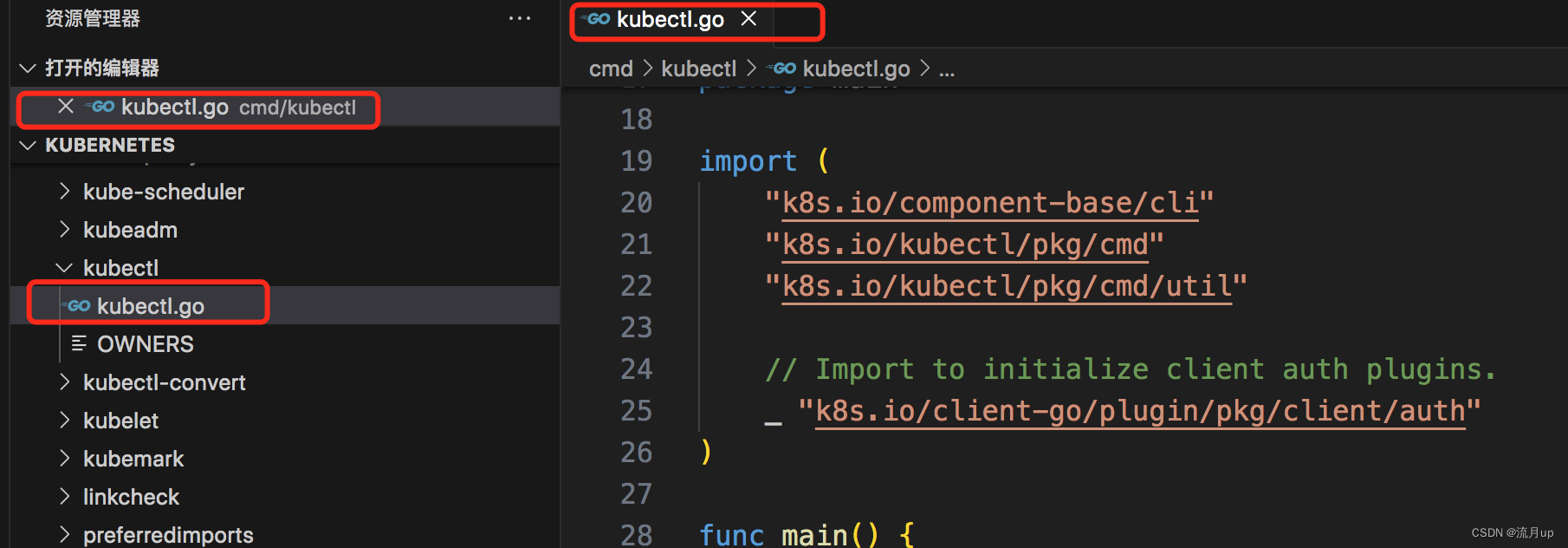目录
概述
k8s 版本 v1.24.16
kubectl的职责
- 1.主要的工作是处理用户提交的东西(包括,命令行参数,yaml文件等)
- 2.将用户提交的这些东西组织成一个数据结构体
- 3.再将其发送给 api server
实践
| 文章名 | 链接 |
|---|---|
| linux k8s 源码编译及单集群测试 | 地址 |
| k8s源码debug | 地址 |
样例
cat test/fixtures/doc-yaml/user-guide/pod.yaml
apiVersion: v1
kind: Pod
metadata:
name: nginx
labels:
app: nginx
spec:
containers:
- name: nginx
image: nginx
ports:
- containerPort: 80
| 字段名 | 含义 |
|---|---|
| kind | Pod |
| metadata.name | |
| spec.containers.name | |
| spec.containers.image | image名称:版本 |
对象规约(Spec) 与状态 (Status)
- 几乎每个 Kubernetes 对象包含两个嵌套的对象字段,它们负责管理对象的配置:对象 spec (规约) 和对象 status (状态)
- 对于具有 spec 的对象,必须在创建对象时设置具体内容,描述你希望对象所具有的特征:期望状态 (Desired State)
yaml 中的必须字段
- 在想要创建的 Kubernetes 对象对应的 yaml 文件中,需要配置如下的字段:
- apiVersion - 创建该对象所使用的 Kubernetes API 的版本
- kind - 想要创建的对象的类别
- metadata - 帮助唯一标识对象的一些数据,包括一个 name 字符串、UID和可选的 namespace
[root@test kubernetes]# ./cluster/kubectl.sh get pods
NAME READY STATUS RESTARTS AGE
nginx 1/1 Running 0 89s
| 字段名 | 含义 |
|---|---|
| NAME | nginx就是对应yaml中metadata.name |
| READY | 就绪个数 |
| STATUS | 当前的状态,RUNNING表示运行中 |
| RESTARTS | 重启的次数,代表没有重启过 |
| AGE | 运行的时长 |
kubectl 代码原理
- 1.从命令行和 yaml 文件中获取信息
- 2.通过 Builder 模式并将其转成一系列的资源
- 3.最后用 Visitor 模式来迭代处理这些 Resources
源码位置
kubectl 命令行设置pprof 抓取火焰图
kubectl 中的 cobra
- 底层函数 NewKubectlCommand 解析
- 在 PersistentPreRunE 设置 prrof 采集相关指令
- 在 PersistentPostRunE 设置了 pprof 统计结果落盘
- 执行采集 pprof cpu 的 kubelet 命令
kubectl.go --> command := cmd.NewDefaultKubectlCommand()
cmd.go --> return NewDefaultKubectlCommandWithArgs(KubectlOptions{ -->cmd := NewKubectlCommand(o)
# cpu.pprof 文件在当前命令执行目录下
kubectl get node --profile=cpu --profile-output=cpu.pprof
# ll
# 使用 go 工具将 pprof 转换成 svg 火焰图
go tool pprof -svg cpu.pprof > kubectl_get_node_cpu.svg
# 下载下来,在浏览器打开
七大分组命令
kubectl.go --> command := cmd.NewDefaultKubectlCommand()
cmd.go --> var defaultConfigFlags = genericclioptions.NewConfigFlags(true).WithDeprecatedPasswordFlag().WithDiscoveryBurst(300).WithDiscoveryQPS(50.0) --> f := cmdutil.NewFactory(matchVersionKubeConfigFlags) --> proxyCmd := proxy.NewCmdProxy(f, o.IOStreams)
proxyCmd.PreRun = func(cmd *cobra.Command, args []string) {
kubeConfigFlags.WrapConfigFn = nil
}
groups := templates.CommandGroups{
{
Message: "Basic Commands (Beginner):",
Commands: []*cobra.Command{
create.NewCmdCreate(f, o.IOStreams),
expose.NewCmdExposeService(f, o.IOStreams),
run.NewCmdRun(f, o.IOStreams),
set.NewCmdSet(f, o.IOStreams),
},
},
{
Message: "Basic Commands (Intermediate):",
Commands: []*cobra.Command{
explain.NewCmdExplain("kubectl", f, o.IOStreams),
getCmd,
edit.NewCmdEdit(f, o.IOStreams),
delete.NewCmdDelete(f, o.IOStreams),
},
},
{
Message: "Deploy Commands:",
Commands: []*cobra.Command{
rollout.NewCmdRollout(f, o.IOStreams),
scale.NewCmdScale(f, o.IOStreams),
autoscale.NewCmdAutoscale(f, o.IOStreams),
},
},
{
Message: "Cluster Management Commands:",
Commands: []*cobra.Command{
certificates.NewCmdCertificate(f, o.IOStreams),
clusterinfo.NewCmdClusterInfo(f, o.IOStreams),
top.NewCmdTop(f, o.IOStreams),
drain.NewCmdCordon(f, o.IOStreams),
drain.NewCmdUncordon(f, o.IOStreams),
drain.NewCmdDrain(f, o.IOStreams),
taint.NewCmdTaint(f, o.IOStreams),
},
},
{
Message: "Troubleshooting and Debugging Commands:",
Commands: []*cobra.Command{
describe.NewCmdDescribe("kubectl", f, o.IOStreams),
logs.NewCmdLogs(f, o.IOStreams),
attach.NewCmdAttach(f, o.IOStreams),
cmdexec.NewCmdExec(f, o.IOStreams),
portforward.NewCmdPortForward(f, o.IOStreams),
proxyCmd,
cp.NewCmdCp(f, o.IOStreams),
auth.NewCmdAuth(f, o.IOStreams),
debug.NewCmdDebug(f, o.IOStreams),
},
},
{
Message: "Advanced Commands:",
Commands: []*cobra.Command{
diff.NewCmdDiff(f, o.IOStreams),
apply.NewCmdApply("kubectl", f, o.IOStreams),
patch.NewCmdPatch(f, o.IOStreams),
replace.NewCmdReplace(f, o.IOStreams),
wait.NewCmdWait(f, o.IOStreams),
kustomize.NewCmdKustomize(o.IOStreams),
},
},
{
Message: "Settings Commands:",
Commands: []*cobra.Command{
label.NewCmdLabel(f, o.IOStreams),
annotate.NewCmdAnnotate("kubectl", f, o.IOStreams),
completion.NewCmdCompletion(o.IOStreams.Out, ""),
},
},
}
kubectl create
// 进入口
create.NewCmdCreate(f, o.IOStreams)
// 核心的cmd.Run函数
// 校验文件参数
if cmdutil.IsFilenameSliceEmpty(o.FilenameOptions.Filenames, o.FilenameOptions.Kustomize) {
ioStreams.ErrOut.Write([]byte("Error: must specify one of -f and -k\n\n"))
defaultRunFunc := cmdutil.DefaultSubCommandRun(ioStreams.ErrOut)
defaultRunFunc(cmd, args)
return
}
// 完善并填充所需字段
cmdutil.CheckErr(o.Complete(f, cmd))
// 校验参数
cmdutil.CheckErr(o.ValidateArgs(cmd, args))
// 核心的RunCreate
// 发送请求与 api server 通信
cmdutil.CheckErr(o.RunCreate(f, cmd))
createCmd中的builder模式
createCmd中的builder建造者设计模式
// 快速定位代码
cmdutil.CheckErr(o.RunCreate(f, cmd)) -->
r := f.NewBuilder().
Unstructured().
Schema(schema).
ContinueOnError().
NamespaceParam(cmdNamespace).DefaultNamespace().
FilenameParam(enforceNamespace, &o.FilenameOptions).
LabelSelectorParam(o.Selector).
Flatten().
Do()

createCmd中的visitor访问者模式
- 访问都模式(Visitor Pattern) 是一种将数据结构与数据操作分离的设计模式
- 指封装一些作用于某种数据结构中的各元素的操作
- 可以在不改变数据结构的前提下定义作用于这些元素的新的操作
- 属于行为型设计模式
使用场景:
- 数据结构稳定,作用于数据结构的操作经常变化的场景
- 需要数据结构与数据操作分享的场景
- 需要对不同数据类型(元素)进行操作,而不使用分支判断具体类型的场景
// 快速定位代码
cmdutil.CheckErr(o.RunCreate(f, cmd)) --> err = r.Visit(func(info *resource.Info, err error) error {
// 注意 Visit 是由 Builder 中 FilenameParam 构建的
r := f.NewBuilder().
...
// 构建 Visit
FilenameParam(enforceNamespace, &o.FilenameOptions).
...
// 创建 Visit
Do()
// 定位
FilenameParam --> b.Path(recursive, matches...) --> visitors, err := ExpandPathsToFileVisitors(b.mapper, p, recursive, FileExtensions, b.schema) -->
visitor := &FileVisitor{
Path: path,
StreamVisitor: NewStreamVisitor(nil, mapper, path, schema),
}
FilenameParam --> b.Path(recursive, matches…) 位置
// NewStreamVisitor is a helper function that is useful when we want to change the fields of the struct but keep calls the same.
func NewStreamVisitor(r io.Reader, mapper *mapper, source string, schema ContentValidator) *StreamVisitor {
return &StreamVisitor{
Reader: r,
mapper: mapper,
Source: source,
Schema: schema,
}
}
// 解析 yaml 或者 json 配置
// Visit implements Visitor over a stream. StreamVisitor is able to distinct multiple resources in one stream.
func (v *StreamVisitor) Visit(fn VisitorFunc) error {
d := yaml.NewYAMLOrJSONDecoder(v.Reader, 4096)
for {
ext := runtime.RawExtension{}
if err := d.Decode(&ext); err != nil {
if err == io.EOF {
return nil
}
return fmt.Errorf("error parsing %s: %v", v.Source, err)
}
// TODO: This needs to be able to handle object in other encodings and schemas.
ext.Raw = bytes.TrimSpace(ext.Raw)
if len(ext.Raw) == 0 || bytes.Equal(ext.Raw, []byte("null")) {
continue
}
if err := ValidateSchema(ext.Raw, v.Schema); err != nil {
return fmt.Errorf("error validating %q: %v", v.Source, err)
}
info, err := v.infoForData(ext.Raw, v.Source)
if err != nil {
if fnErr := fn(info, err); fnErr != nil {
return fnErr
}
continue
}
if err := fn(info, nil); err != nil {
return err
}
}
}
// 上面方法中,重点如下代码
info, err := v.infoForData(ext.Raw, v.Source)
// obj 代表 k8s的对象
// gvk 代表 Group/Version/Kind 的缩写
obj, gvk, err := m.decoder.Decode(data, nil, nil)
外层VisitorFunc分析
- 如查出错即返回错误
- DryRunStrategy 代表试运行策略
- 默认为 None 代表不试运行
- client 代表客户端试运行,不发送请求至 server
- server 点服务端试运行,发送请求,但是如果会改变状态的话就不做
err = r.Visit(func(info *resource.Info, err error) error { --> if o.DryRunStrategy != cmdutil.DryRunClient { --> Create(info.Namespace, true, info.Object)(最终创建资源)
结束
kubectl使用及进阶 至此结束。


























 7789
7789











 被折叠的 条评论
为什么被折叠?
被折叠的 条评论
为什么被折叠?










